Mechanical Properties of a PLA/Nettle Agro-Composite with 10% Oriented Fibers
Abstract
Featured Application
Abstract
1. Introduction
2. Materials and Methods
2.1. Nettle Fibers
2.1.1. Mechanical Properties of the Nettle Fibers
2.1.2. Optical Analysis of the Fibers
2.2. Polylactic Acid
2.2.1. Mechanical Properties of the PLA
2.2.2. Differential Scanning Calorimetry (DSC) of the PLA
2.3. Constitution of PLA/Nettle Plates; Operating Mode
2.3.1. Agro-Composite Plate Manufacturing
2.3.2. Fibers’ Orientation in the Plate
2.3.3. Physico-Chemical Analysis of a PLA/Nettle Plate, Choice of Fiber Arrangement
2.3.4. SEM Analysis of the Plate
3. Sample Preparation and Mechanical Tests
4. Results and Discussion
5. Conclusions
Author Contributions
Funding
Institutional Review Board Statement
Informed Consent Statement
Data Availability Statement
Acknowledgments
Conflicts of Interest
References
- JEC Observer. Overview of the Global Composites Market. 2021–2026. Available online: https://www.jeccomposites.com/press/jec-observerbroverview-of-the-globalbrcomposites-market-2021-2026-eco/ (accessed on 3 March 2022).
- Manu, T.; Reza Nazmi, A.; Shahri, B.; Emerson, N.; Huber, T. Biocomposites: A review of materials and perception. Mater. Today Commun. 2022, 31, 103308. [Google Scholar] [CrossRef]
- Chang, B.P.; Rodriguez-Uribe, A.; Mohanty, A.K.; Misra, M. A comprehensive review of renewable and sustainable biosourced carbon through pyrolysis in biocomposites uses: Current development and future opportunity. Renew. Sustain. Energy Rev. 2021, 152, 111666. [Google Scholar] [CrossRef]
- Andrew, J.J.; Dhakal, H.N. Sustainable biobased composites for advanced applications: Recent trends and future opportunities—A critical review. Compos. Part C Open Access 2022, 7, 100220. [Google Scholar] [CrossRef]
- Mahmud, S.; Hasan, K.M.F.; Jahid, M.A.; Mohiuddin, K.; Zhang, R.; Zhu, J. Comprehensive review on plant fiber-reinforced polymeric biocomposites. J. Mater. Sci. 2021, 56, 7231–7264. [Google Scholar] [CrossRef]
- Bogard, F.; Bach, T.; Abbes, B.; Bliard, C.; Maalouf, C.; Bogard, V.; Beaumont, F.; Polidori, G. A comparative review of Nettle and Ramie fiber and their use in biocomposites, particularly with a PLA matrix. J. Nat. Fibers 2021. [CrossRef]
- Hassler, M. World Plants: Synonymic Checklists of the Vascular Plants of the World. Cat. Life 2020. [Google Scholar] [CrossRef]
- Allais, D. L’ortie dioïque. L’Imag. Méd. 2009, 48, 53–55. [Google Scholar] [CrossRef]
- Draghy, F. L’ortie dioïque (Urtica dioica): Étude bibliographique. Sci. Pharm. 2005. [Google Scholar]
- Bodros, E.; Baley, C. Study of the tensile properties of stinging Nettle fibres (Urtica dioica). Mater. Lett. 2008, 62, 2143–2145. [Google Scholar] [CrossRef]
- Koronis, G.; Silva, A.; Fontul, M. Green Composites: A review of adequate materials for automotive applications. Compos. Part B 2013, 44, 120–127. [Google Scholar] [CrossRef]
- Torres, J.P.; Vandi, L.J.; Veidt, M.; Heitzmann, M.T. The mechanical properties of natural fibre composite laminates: A statistical study. Compos. Part A Appl. Sci. Manuf. 2017, 98, 99–104. [Google Scholar] [CrossRef]
- Summerscales, J.D.; Dissanayake, N.P.J.; Virk, A.S.; Hall, W. A review of bast fibres and their composites. Part 1—Fibres as reinforcements. Compos. Part A 2010, 41, 1329–1335. [Google Scholar] [CrossRef]
- Shahzad, A. Mechanical properties of lignocellulosic fiber composites. In Lignocellulosic Fibre and Biomass-Based Composite Materials; Jawaid, M., Tahir, P., Saba, N., Eds.; Woodhead Publishing Series in Composites Science and Engineering: Sawston, UK, 2017; pp. 193–223. [Google Scholar] [CrossRef]
- Scida, D.B.; Bourmaud, A.; Baley, C. Influence of the scattering of flax fibres properties on flax-epoxy woven ply stiffness. Mater. Des. 2017, 122, 136–145. [Google Scholar] [CrossRef]
- Bledzki, A.K.; Gassan, L. Composites reinforced with cellulose based fibres. Prog. Polym. Sci. 1999, 24, 221–274. [Google Scholar] [CrossRef]
- Rowell, R.M.; Han, J.; Rowell, J. Characterization and factors effecting fiber propertie. Nat. Polym. Agrofibers Based Compos. 2000, 115–134. Available online: https://www.researchgate.net/publication/237255433_Characterization_and_Factors_Effecting_Fiber_Properties (accessed on 26 September 2022).
- Eichhorn, S.J.; Baillie, C.; Zafeiropoulos, N.; Mwaikambo, L.Y.; Ansell, M.P.; Dufresne, A.; Entswistle, K.M.; Herrera-Franco, P.; Canché-Escamilla, G.; Groom, H.; et al. Current international research into cellulosic fibres and composites. J. Mater. Sci. 2001, 36, 2107–2131. [Google Scholar] [CrossRef]
- Frollini, E.; Leao, A.; Mattoso, L.H.C.; Rowell, R.; Han, J.; Rowell, J. Cellulose nanocrystals: Pretreatments, preparation strategies, and surface functionalization. Int. J. Biol. Macromol. 2021, 182, 1554–1581. [Google Scholar]
- Do Thi, V. Matériaux Composites à Fibres Naturelles/Polymère Biodégradables ou Non. Ph.D. Thesis, Université de Grenoble, Grenoble, France, 2011. [Google Scholar]
- Bergfjord, C.; Holst, B. A procedure for identifying textile bast fibres using microscopy: Flax, Nettle/Ramie, hemp and jute. Ultramicroscopy 2010, 110, 1192–1197. [Google Scholar] [CrossRef]
- Gourier, C. Contribution à L’étude de Matériaux Biocomposites à Matrice Thermoplastique Polyamide-11 et Renforcés Par des Fibres de Lin. Ph.D. Thesis, Université de Bretagne Sud, Lorient, France, 2016. [Google Scholar]
- Baley, C. Analysis of the flax fibres tensile behaviour and analysis of the tensile stiffness increase. Comp. Part A Appl. Sci. Manuf. 2002, 33, 939–948. [Google Scholar] [CrossRef]
- Murariu, M.; Dubois, P. PLA composites: From production to properties. Adv. Drug Deliv. Rev. 2016, 107, 17–46. [Google Scholar] [CrossRef]
- Kueny, R. Biocomposites: Composites de Hautes Technologies à Renfort de Fibres Naturelles et Matrice de Résines Naturelles. Ph.D. Thesis, Université de Lorraine, Nancy, France, 2018. [Google Scholar]
- Yorseng, K.; Rangappa, S.M.; Pulikkalparambil, H.; Siengchin, S.; Parameswaranpillai, J. Accelerated weathering studies of kenaf/sisal fiber fabric reinforced fully biobased hybrid bioepoxy composites for semi-structural applications: Morphology, thermo-mechanical, water absorption behavior and surface hydrophobicity. Construct. Build. Mater. 2020, 235, 117464. [Google Scholar] [CrossRef]
- Lee, C.H.; Khalina, A.; Lee, S.H. Importance of Interfacial Adhesion Condition on Characterization of Plant-Fiber-Reinforced Polymer Composites: A Review. Polymers 2021, 13, 438. [Google Scholar] [CrossRef] [PubMed]
- Du, Y.; Yan, N.; Kortschot, M.T. The use of Ramie fibers as reinforcements in composites. In Biofiber Reinforcements in Composite Materials; Faruk, O., Sain, M., Eds.; Woodhead Publishing: Sawston, UK, 2015; pp. 104–137. [Google Scholar] [CrossRef]
- Kumar, N.; Das, D. Alkali treatment on nettle fibers Part I: Investigation of chemical, structural, physical, and mechanical characteristics of alkali-treated nettle fibers. J. Text. Inst. 2016, 108, 1461–1467. [Google Scholar] [CrossRef]
- Thilgavathi, G.; Karan, C.P. Investigations on oil sorptions capacity of Nettle fibrous assembly and 100% Nettle and Nettle/kapok blended needle punched nonwovens. J. Indus. Text. 2019, 49, 415–430. [Google Scholar] [CrossRef]
- Davies, G.C.; Bruce, D.M. Effect of relative humidity and damage on the tensile properties of flax and Nettle fibers. Text. Res. J. 1998, 68, 623–629. [Google Scholar] [CrossRef]
- Bajpai, P.K.; Meena, D.; Vasta, S.; Singh, I. Tensile behavior of Nettle fiber composites exposed to various environments. J. Nat. Fibers 2015, 10, 244–256. [Google Scholar] [CrossRef]
- Bar, M.; Alagirusamy, R.; Das, A. Properties of flax-polypropylene composites made through hybrid yarn and film stacking methods. Compos. Struc. 2018, 197, 63–71. [Google Scholar] [CrossRef]
- Ramdani, N.; Derradji, M.; Mokhnach, E.O. Natural fiber reinforced polybenzoxazine composites: A review. Mater. Today Commun. 2022, 31, 103645. [Google Scholar] [CrossRef]
- Zhan, J.; Wang, G.; Li, J.; Guan, Y.; Zhao, G.; Naceur, H.; Coutellier, D.; Lin, J. Effect of the compatilizer and chemical treatments on the performance of poly (lactic acid)/ramie fiber composites. Compos. Commun. 2021, 27, 100843. [Google Scholar] [CrossRef]
- Chen, X.; Ren, J.; Zhang, N.; Gu, S.; Li, J. Effects of heat treatment on the thermal and mechanical properties of fabric-reinforced PLA bio composite. J. Reinf. Plast. Compos. 2015, 34, 28–36. [Google Scholar] [CrossRef]
- Xu, H.; Liu, C.; Chen, C.; Hsiao, B.S.; Zhong, G.; Li, Z. Easy alignment and effective nucleation activity of Ramie fibers in injection-molded poly (lactic acid) biocomposite. Biopolymers 2012, 97, 825–839. [Google Scholar] [CrossRef]
- Yu, T.; Ren, J.; Li, S.; Yuan, H.; Li, Y. Effect of fiber surface-treatments on the properties of poly (lactic acid)/Ramie composites. Compos. Part A 2010, 41, 499–505. [Google Scholar] [CrossRef]
- Kumar, N.; Das, D. Fibrous biocomposites from Nettle (Girardinia diversifolia) and poly (lactic acid) fibers for automotive dashboard panel application. Compos. Part B 2017, 130, 54–63. [Google Scholar] [CrossRef]
- Moonart, U.; Utara, S. Effect of surface treatments and filler loading on the properties of hemp fiber/natural rubber composites. Cellulose 2019, 26, 7271–7295. [Google Scholar] [CrossRef]
- Kumar, N.; Das, D.; Neckar, B. Effect of fiber orientation on tensile behavior of biocomposites prepared from Nettle and poly (lactic acid) fibers: Modeling & experiment. Compos. Part B 2018, 138, 113–121. [Google Scholar] [CrossRef]
- Fischer, H.; Werwein, E.; Graupner, N. Nettle fibre (Urtica dioica L.) reinforced poly (lactic acid): A first approach. J. Compos. Mater. 2012, 46, 3077–3087. [Google Scholar] [CrossRef]
- Pokhriyal, M.; Prasad, L.; Rakesh, P.K.; Raturi, H.P. Influence of fiber loading on physical and mechanical properties of Himalayan Nettle fabric reinforced polyester composite. Mater. Today Proc. 2018, 5, 16973–16982. [Google Scholar] [CrossRef]
- Nandi, P.; Das, D. Mechanical, thermo-mechanical and biodegradation behaviors of green-composites prepared from woven structural nettle (Girardinia diversifolia) reinforcement and poly (lactic acid) fibers. Ind. Crops Prod. 2022, 175, 114247. [Google Scholar] [CrossRef]
- Rajeshkumar, G.; Arvindh Seshadri, S.; Devnani, G.L.; Sanjay, M.R.; Siengchin, S.; Prakash Maran, J.; Al-Dhabi, N.A.; Karuppiah, P.; Mariadhas, V.A.; Sivarajasekar, N.; et al. Environment friendly, renewable and sustainable poly lactic acid (PLA) based natural fiber reinforced composites—A comprehensive review. J. Clean. Prod. 2021, 310, 127483. [Google Scholar] [CrossRef]
- Ségard, E.; Benmedakhene, S.; Laksimi, A.; Laï, D. Damage analysis and the fibre–matrix effect in polypropylene reinforced by short glass fibres above glass transition temperature. Compos. Struct. 2003, 60, 67–72. [Google Scholar] [CrossRef]
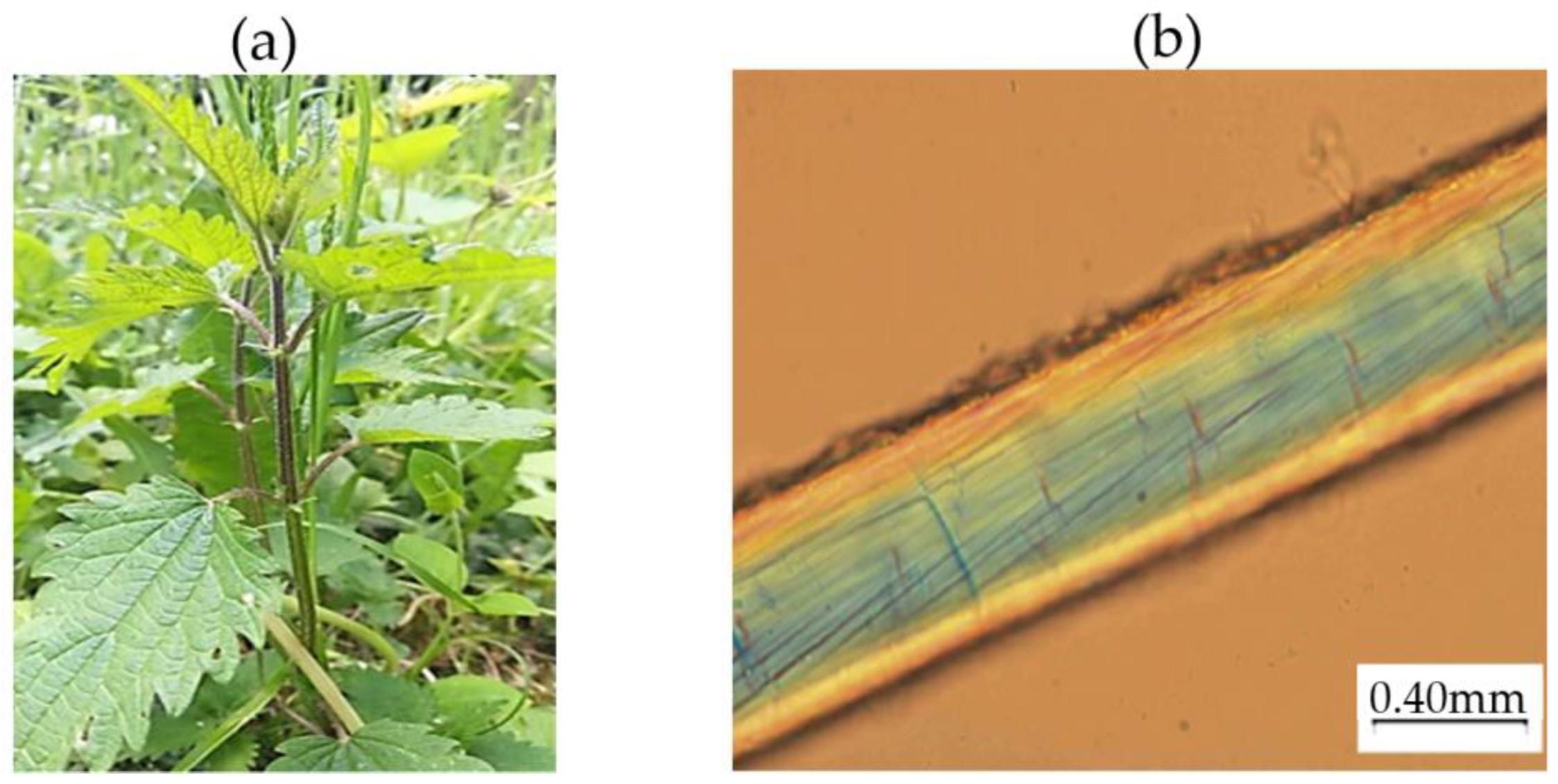


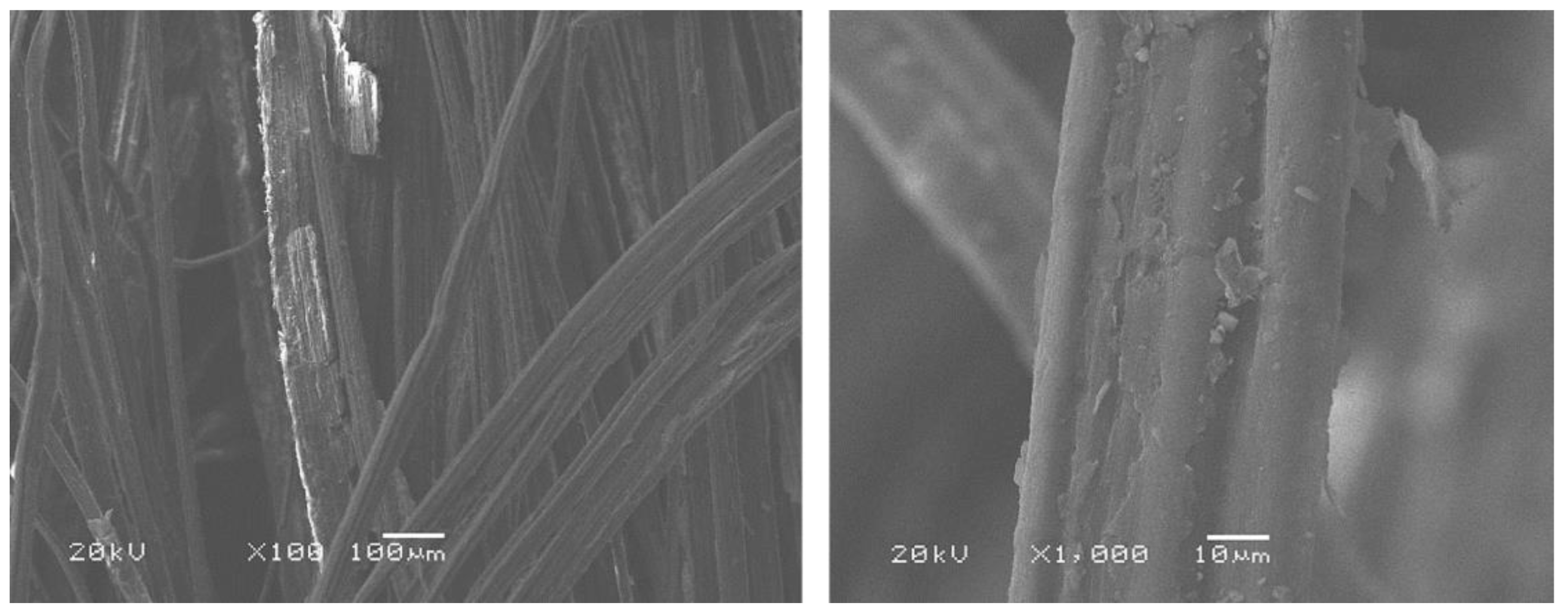

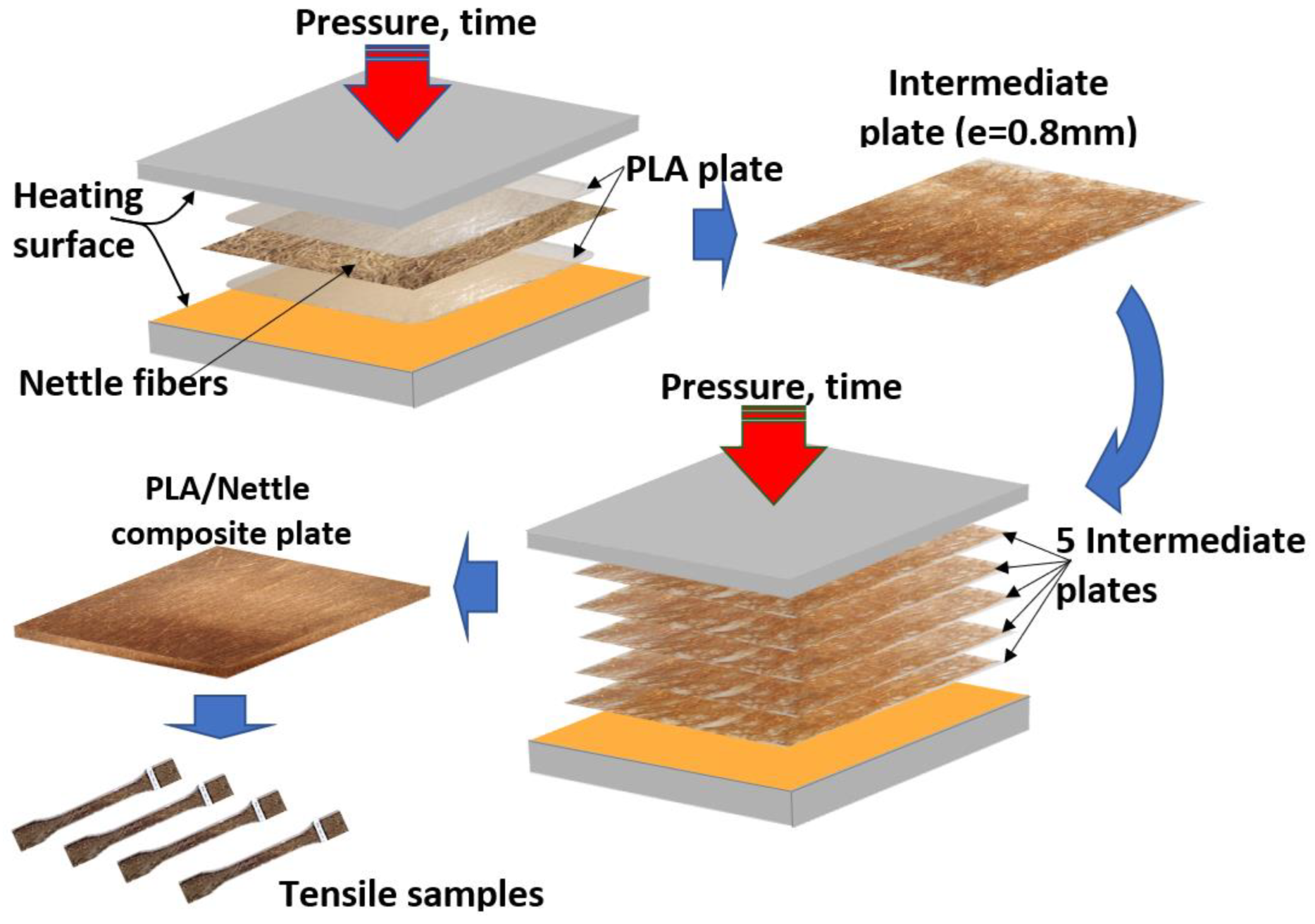


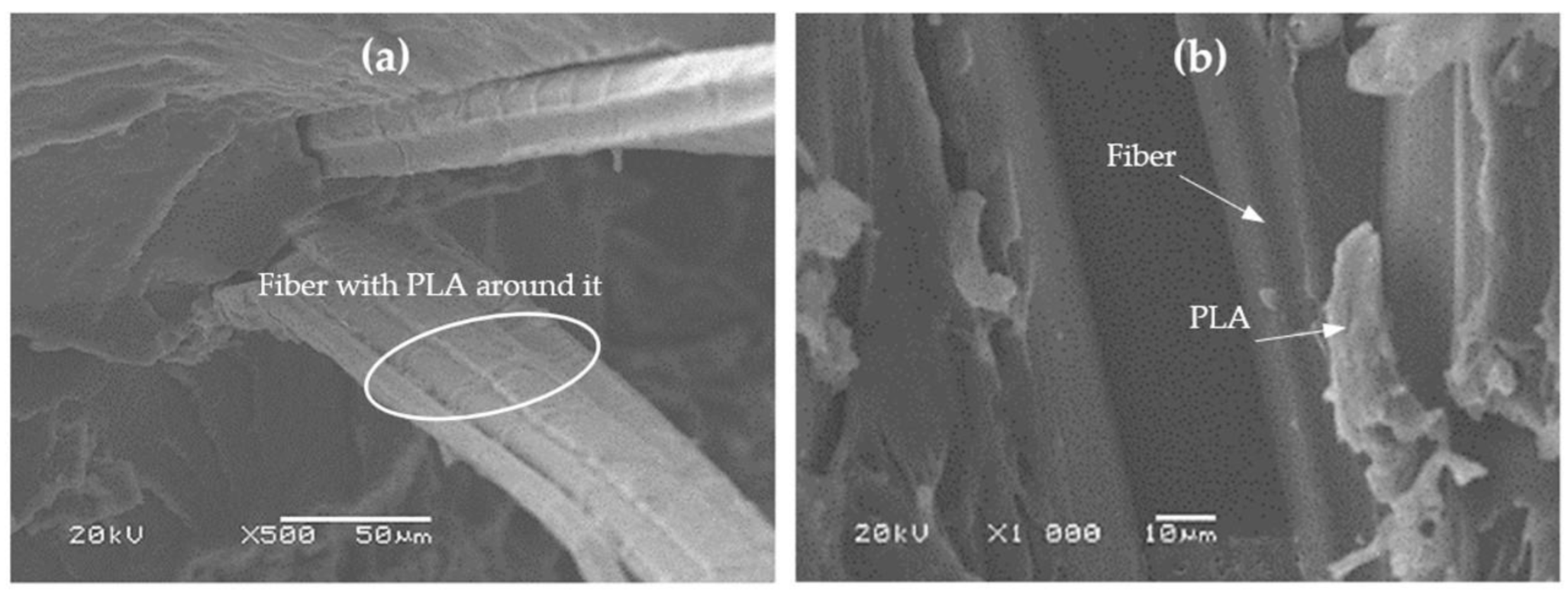




| Supplier Data | Young’s Modulus (GPa) | Tensile Strength (MPa) | Elongation at Break (%) | SF Density (g/cm3) |
|---|---|---|---|---|
 | 13.93 ± 6.83 | 299.38 ± 182.08 | 2.33 ± 0.62 | 1.18 ± 0.12 |
| Supplier Data | Young Modulus (GPa) | Tensile Strength (MPa) | Elongation at Break (MPa) | Density (g/cm3) |
|---|---|---|---|---|
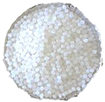 | 3.6 | 60 | 6 | 1.24 |
| SFUD 0° | RFUD 0° | SFUD 45° | RFUD 45° | PLA | |
|---|---|---|---|---|---|
| Tg (°C) | 59.06 | 59.38 | 57.16 | 59.07 | 61.16 |
| Tc (°C) | 126.44 | 129.13 | 121.48 | 124.99 | 126.52 |
| Tf (°C) | 153.23 | 152.92 | 150.74 | 152.23 | 153.35 |
| R (%) | 14.1 | 9 | 26.1 | 19.6 | 0.7 |
| Samples from Plate (with Sorted Fibers and Raw Fibers) | Young’s Modulus (GPa) | Tensile Strength (MPa) | Elongation at Break (%) | |||
|---|---|---|---|---|---|---|
| Average | SD | Average | SD | Average | SD | |
| SF UD0° | 5.41 | ±0.23 | 53.98 | ±3.11 | 1.24 | ±0.05 |
| RF UD0° | 4.51 | ±0.19 | 44.70 | ±3.36 | 1.21 | ±0.07 |
| SF UD45° | 3.85 | ±0.08 | 35.89 | ±2.58 | 1.19 | ±0.10 |
| RF UD45° | 3.99 | ±0.07 | 38.21 | ±3.64 | 1.24 | ±0.12 |
| Composite | Obtention Process | Fiber Length (mm) | Treatment | Fiber (Mass Ratio) | Young’s Modulus (GPa) | Tensile Strength (MPa) | Elongation at Break (%) |
|---|---|---|---|---|---|---|---|
| Present studyPLA/nettle | Intermediate plate | 10 < L < 70 | - | 10 | 5.41 ± 0.23 | 53.98 ± 3.11 | 1.24 ± 0.05 |
| nettle/PLA [39] | Nettle and PLA fibers carded and molded | 55 ± 1 | NaOH | 10 25 50 | 2.37 ± 0.05 3.11 ± 0.05 3.34 ± 0.04 | 15.54 ± 0.45 36.70 ± 1.30 50.82 ± 0.82 | 1.42 ± 0.06 1.80 ± 0.08 2.45 ± 0.10 |
| nettle/PLA [42] | Nettle and PLA fibers carded and molded | Woven fabric | - | 20 30 40 | 4.8/3.5 5.6/3.5 4.8/3.5 | 45/52 59/52 40/52 | 1.2/1.8 1.5/1.8 1.3/1.8 |
| nettle/PS [43] | Hand layup technique | fabric | - | 5 10 15 20 | - | ~19.8 ± 0.67 ~23.22 ± 0.85 ~30.69 ± 0.57 ~29.08 ± 0.81 | - |
| ramie/PLA [36] | Ramie fabric and PLA molded | fabric | - | 24 38 | 1.64 1.2 | 66.33 29.37 | 4 3 |
| ramie/PLA [38] | two-roll mill heated | 10 | NaOH-silane | 30 | 2/4 | 52/66.8 | 3.2/4.8 |
| nettle/PLA [44] | PLA fiberwebs molded | fabric | - | 20 35 50 | 3.35 ± 0.12 3.97 ± 0.08 4.37 ± 0.14 | 35.56 ± 1.16 38.35 ± 0.30 39.87 ± 0.60 | 1.59 ± 0.12 1.76 ± 0.05 2.18 ± 0.07 |
| nettle/PP [32] | Film stacking | Woven mat | - | - | - | 32.56 | - |
Publisher’s Note: MDPI stays neutral with regard to jurisdictional claims in published maps and institutional affiliations. |
© 2022 by the authors. Licensee MDPI, Basel, Switzerland. This article is an open access article distributed under the terms and conditions of the Creative Commons Attribution (CC BY) license (https://creativecommons.org/licenses/by/4.0/).
Share and Cite
Bogard, F.; Bach, T.; Bogard, V.; Beaumont, F.; Murer, S.; Bliard, C.; Polidori, G. Mechanical Properties of a PLA/Nettle Agro-Composite with 10% Oriented Fibers. Appl. Sci. 2022, 12, 9835. https://doi.org/10.3390/app12199835
Bogard F, Bach T, Bogard V, Beaumont F, Murer S, Bliard C, Polidori G. Mechanical Properties of a PLA/Nettle Agro-Composite with 10% Oriented Fibers. Applied Sciences. 2022; 12(19):9835. https://doi.org/10.3390/app12199835
Chicago/Turabian StyleBogard, Fabien, Thierry Bach, Virginie Bogard, Fabien Beaumont, Sébastien Murer, Christophe Bliard, and Guillaume Polidori. 2022. "Mechanical Properties of a PLA/Nettle Agro-Composite with 10% Oriented Fibers" Applied Sciences 12, no. 19: 9835. https://doi.org/10.3390/app12199835
APA StyleBogard, F., Bach, T., Bogard, V., Beaumont, F., Murer, S., Bliard, C., & Polidori, G. (2022). Mechanical Properties of a PLA/Nettle Agro-Composite with 10% Oriented Fibers. Applied Sciences, 12(19), 9835. https://doi.org/10.3390/app12199835








